Growing Curry Leaves Plant is easy when you know all the right tips and tricks. Here’s everything you need to know and more!

Curry leaves are native to the Indian subcontinent and are often mixed with Helichrysum Italicum (which is also called curry plant in confusion). Its leaves are aromatic — sweet and pungent, which releases a mouthwatering fragrance and is used in cooking. Keep reading this article to learn about the Growing Curry Leaves Plant!
Botanical Name: Murraya koenigii
Other Names: Curry tree, Curry leaves tree, Curry plant, Sweet neem, Meethi neem, Kadhi patta.
USDA Zones: 9-12
Read about Herbs You Should Never Buy But Grow Instead at Home
Best Varieties of Curry Leaves Plant
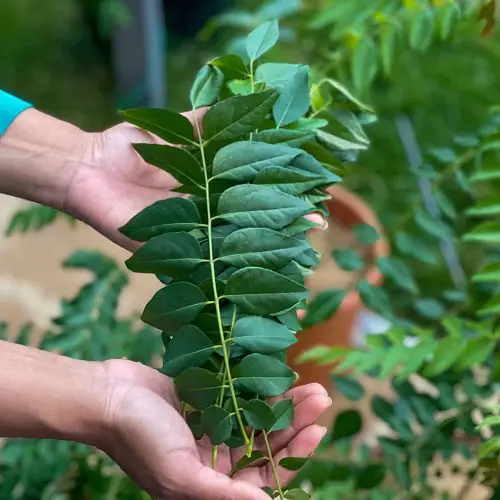
Curry leaf plant comes in three distinct varieties with their own set of pros and cons – Regular, Dwarf, and Gamthi.
- Regular Curry Tree: It grows up very fast and reaches a height of 6-15 feet and a width of 4-12 feet. The leaves of this plant are commonly found in grocery stores and are the most widely cultivated out of the three available options.
- Dwarf Variety: Helichrysum angustifolium ‘Nana’ is a short version. It is an excellent choice for a houseplant or to grow in containers to decorate your patio that could also be placed indoors during winter.
- Gamthi: It is even smaller than the dwarf variety and reaches 6-8 inches in height on full maturity. However, it does not spread as quickly but makes up for it by producing the most fragrant leaves of all curry plants.
Discover Grow Herbs Year Round Without Soil With this Method
Propagating Curry Leaves Plant
Curry Leaves tree propagation can be achieved by either seed or vegetative means. Seeds should be sown in a well-draining soil mix and placed in a warm, sunny spot.
Vegetative propagation can be accomplished by taking cuttings from mature trees and planting them in a potting mix. The cuttings should be taken from healthy branches and should be about 3-4 inches in length.
Once planted, the cuttings should be watered regularly and placed in a sunny spot.
Check out the Best Indoor Herbs to Grow from Cuttings
Planting Curry Tree
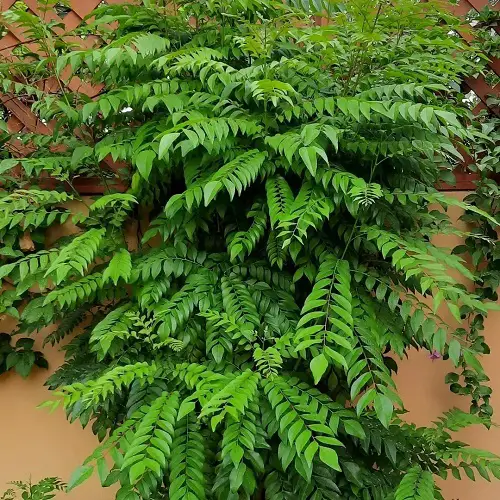
Planting a Curry Tree in Warmer Regions
If you live in USDA Zone 9-11, grow it outside. Plant it in the sunniest spot in your garden, and do regular watering in the next two months. Pinch off its white flowers in the first two years to appreciate healthy growth. Once settled, it’ll start to grow up quickly.
Planting a Curry Tree in Cooler Areas
Gardeners below USDA Zone 9 or with harsh winters should grow it in a container. Spring is the best season for planting. Plant this in a 5-gallon container and upgrade its size as the growth progresses.
In colder climates, you may need to bring the container indoors during winter. Place the container in a cool, dark spot with temperatures between 60-70°F. Allow the soil to dry out between waterings and fertilize every few months.
With proper care, you can successfully grow a curry tree in cooler climates.
Explore Herbs with Shallow Roots for Small Pots
Requirements for Growing Curry Leaves Plant
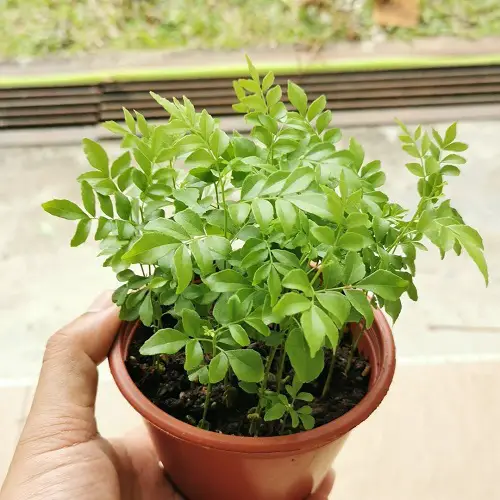
Sunlight
Native to India, the tree loves the full sun and grows best in it. While the plant is in the growing stage, avoid exposing it to the harsh afternoon sun for a longer duration of time. Once established, you don’t have to worry much about it.
Soil
Using well-draining soil, a general potting soil mix, or soil that is specifically designed for growing citrus trees is ideal.
The soil should be light and airy with plenty of organic matter to help retain moisture and provide nutrients. A pH of 6.5–7.5 is ideal for a curry tree. If the soil is too acidic, you can add powdered lime to raise the pH.
Water
Curry trees flourish in a warm and humid climate and require frequent watering. The tree should be watered when the top inch of soil is dry, using enough water to saturate the root area thoroughly.
Water the tree deeply and slowly, allowing the water to penetrate the soil.
Check out Best Yellow Flowering Herbs
Curry Leaves Plant Care
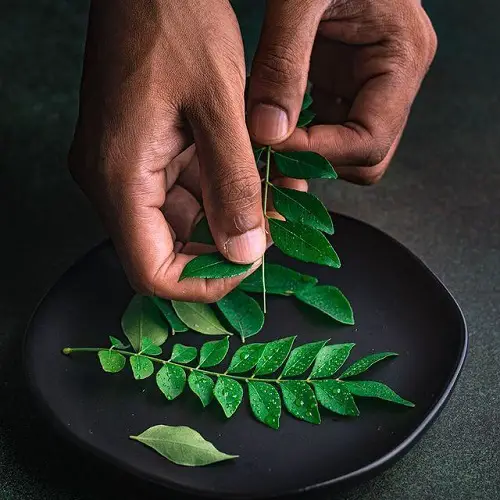
In the beginning, it’s a slow grower and reaches a height of 6-10 inches in a year (depending on the climate and growing conditions), so give it its time to settle.
Fertilizer
For best results, use a slow-release fertilizer specifically designed for tropical plants. This type of fertilizer should be applied every 3-4 months during the growing season.
Additionally, you may want to add a small amount of a balanced fertilizer with a ratio of 10-10-10 once a month during the growing season. Be sure to read and follow the manufacturer’s instructions for application amounts and frequency.
Pruning
Pruning a curry tree is relatively easy and can be done any time of year. The best time to prune a curry tree is in the spring or early summer when the tree is actively growing. Pruning in the late summer or fall should be avoided as it can weaken the tree and cause it to be more susceptible to disease or pests.
When pruning, it is important to remove any dead, diseased, or damaged branches. This will encourage healthy new growth. It is also important to thin out the tree’s canopy to increase airflow and light. This will help reduce the disease risk and make the tree look more attractive.
Be sure to remove any suckers that are growing from the base of the tree. These should be removed as they can take away from the growth of the main branches.
Pests and Diseases
Leaf-feeding caterpillars, aphids, mealybugs, and scale insects can attack the plant. Root rot, powdery mildew, leaf spot, and canker that appear in wet conditions.
Use an insecticidal soap or a neem oil solution to keep pests at bay. For diseases, avoid overwatering the plant and ensure it gets plenty of sunlight.
Harvesting Curry Leaves
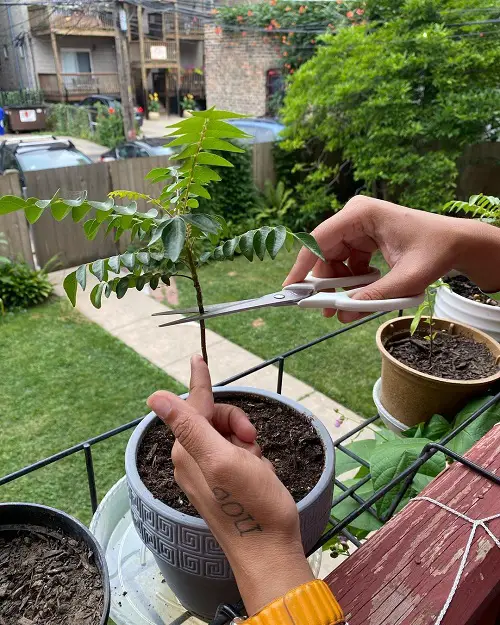
Curry leaves can be harvested by picking the leaves off the stem individually. You can also use scissors or pruning shears to make the process easier.
To harvest, start at the end of the stem and work your way down, picking only the leaves that are fully developed. Do not take all the leaves off the stem at once, as this will leave the plant vulnerable to damage from heat or pests.
Once the leaves are harvested, they can be used fresh or dried later.



Hi as i want to grow curry plant i want to know that what should j plant in mud its whole branch?? And at one place in a pot of 4 to 5 branches at few inches gaps like pudhina ( mint ).
Hi Ayesha, are you asking about “How to Propagate Curry Tree from Cuttings“? If so, yes you can. But don’t plant them together, instead plant them separately in each container as curry plant is difficult to transplant. Please read this.
I am living in Germany, how can i grow the murraya koenigii seed? Can they grow indoor? Thank you for the reply!
Curry leaf plants can be grown from seeds. You can plant ripe(deep red to black) berries and they are not difficult to grow in warm tropical climate conditions. But if you live in a country with severe cold climates, make sure they are kept indoors in warmer conditions. They grow well in good sunlight conditions, but can survive in winter conditions indoors until they can be put outside when the warmer days arrive.
Hi, I stay in Singapore. After picking up the leaves, new leaves are not growing back. Please suggest.
put the leaves back on and it should start growing again
as stupid as you look – if you have nothing nice to say, shut it ugly!
My curry plant is about 2 ft. tall and about 3 yrs old. We live in zone 9 and it is planted in the ground on a slightly raised bed. The leaves do not grow big as in proper curry leaves. They stay small and remain tender and some become darker and then dry and fall off. Why aren’t my leaves growing bigger? What can I do organically to grow it?
Thank you.
One thing left off this article is that it requires an acid soil. I have a 5 year old one that is about 5 feet tall and very healthy, in a 30 gallon container and…seriously, I mix the nutrient solution I give it every few weeks at pH 5.2-5.5. Being as the tap water is pH 8.2, that’s a pretty big difference. You will see a few sites refer to needing a lot of supplemental iron. That’s a symptom of too high a pH in this one, as the Fe is only available at lower pH’s. It doesn’t tolerate weather below 35F, so I have to bring it in on the few freezing days in the winter (Texas).
I’m stunned by the comment about avoiding the wind. My experience- and it’s just how plants work- is that more wind makes the stems stronger. Mine is certainly very strong and easily tolerates squalls that have 1/4″ oak twigs snapping off left and right.
After pruning the curry bush the new growth is growing from the bottom and sideways along the ground. Why is this happening? Should it be staked to encourage upward growth?
I am Looking for Curry Plants…in Spain.?
Plz.Tell Me…
Thanks.
In Europe you can buy curry leaf plants from http://www.curryleaftree.com
They also have curry leaf seeds available a couple of times per year.
I have recently moved into a new compound in Bangalore, India, where there is an old curry leaf tree about 7ft tall planted in the ground. However, the tree appears woody and dry, most of the branches are empty without leaves and there are very few shoots which have small and curling leaves. Kindly advise on how the tree can be pruned and what needs to be done to revive it.
where can we get the curry leave plants in USA?
I got mine from http://WWW.logees.com, came well packaged and healthy.
me too! started as a baby and now it’s getting massive
I am from united states where I can find this curry leaves.
Tifany, where in the US are you? I am in California and found curry leaf tree at a local exotic nursery.
Hi Jessica,
I am Southern California. Could you please share with me what nursery I can get this plant from? Thank you so much.
Hi Gwen,
Many indian stores have small curry leaf plants, mostly in summer. In Southern California, may be in Artesia, you can find it in atleast some stores around April-June.
Hope you get it
Hi. I am in Phoenix and got my first seeds and plants from another gardener in a Facebook gardening group. Look for your local gardening groups on Facebook, then post that you are in search of (ISO) a curry leaf plant.
You can find curry leaf plants on ebay.. or local nurseries (eg in Austin or Florida), OR get curry plant seeds fresh from India ($20 for 50 seeds). Avoid old dried up seeds from Sri Lanka or Hawaii.. they never germinate. Germinate indoors with a heated mat .. and transplant without disturbing roots outdoors. Get the best soil (coir based) and let grow in early summer to late fall.. bring indoors unless in CA or south TX or south FL over winter. Best option is to get nursery grown 6 to 12″ shrubs.. transplant and prune tips in summer for bushy branches to grow. Invest in the best aerated soil and containers (mesh trash cans from Bed Bath work great). Harvest leaves properly to stimulate growth. The plants rae very fragile.. and bad soil kills them quick. Grow in full sun and water often. Enjoy fried fresh curry leaves with nuts or meats or veggies!
Thanks Srini. Great tips. Will try
I’ve just failed to get any of my 30 seeds eBay seed from Sri Lanka to germinate indoors. They looked very old and just went mouldy. I didn’t realise the skin was on them which I’m sure didn’t help.
I’ll try some fresh Indian seeds from eBay. Should I wait until August to increase the chances of them being fresh?
I am starting from seeds and have a few sprouts my question is I am putting them indoors with 12hrs of light is that ok
12 hrs of sunlight with warm room temperatures should be fine but watch out for small scale insects that can weave a fine web.. they can simply be washed away. The soil and too much or too little water are things to watch for.. make sure the container is large enough (5 gallons), with potting mix that holds/drains water.. too much water or no nutrients and the saplings will shrivel away in a day.. once established, in 2 years.. you can take risks like fertilizer or transplanting..
Hi
I bought my curry leave plant from local grocery store . its in a balcony and getting 4 hours of sun ,i am watering twice a week, i am in atlanta in 7B zone, actully the plant is growing v slowly and the leaves seems to be v small and the plants and leaves look v dull and life less ,I got cow manure mix soil, still no improvement, any suggetions? thanks.
Hiii.
My curry leaf plant is not growing. Plz suggest me some tips on how to regrow curry leaves plant.
My curry tree is multiplying! My neighbour had one tree about 6-8′ tall near the fence and suddenly 3-4 plants popped up on my side of the fence in the lawn. My gardener not realising how special they are ‘mowed’ them – however they recovered and I now have at least a dozen small plants – some up to 5 yds away from the host. Can i dig up some of the small plants and pot them without risking the others? is this normal behaviour for this plant
Hi Jo, that would be typical for a curry leaf tree in the right growing climate, they grow and spread like weeds, …..enjoy:)
Don’t remove them too quickly from the motherplant as it’s still depending on the root system of the motherplant in the beginning. The suckers needs to be established for a couple of months so they have developped their own root system.
South Africa what zone are we in I am battling to get my curry leave tree to grow please advise ( Estelle)
Please advise how to eradicate mites, tiny white spiders, and fungus with a home made spray and not chemicals harmful to eat.
Hi,
Last winter my 2 ft tall curry leaf plant continued new growth, including flowering which is not normal in NY area.
But then in spring/summer it stopped growing, some leaves are curling, leaf size is also short and I don’t see any visible bug or disease. So not sure what is wrong.
Please suggest something
Curry leaf plant need acidic or alkaline soil
Curry plant in my home which is planted in soil was healthy and full of leaves,. Suddenly the leaves started withering. On careful examination I noticed growth of parasitic plant on the stem of mother plant. Can you give me some idea of how to contain such stem parasites.
My curry plant lives on the windowsill in the kitchen. Lots of sun but when I pick leaves they dont grow back in the same place. They grow from the top so I have quite a long trunk with no leaves.
Also it seems to be struggling at the moment, could it be because it’s winter and even though its in the kitchen and gets sun, it’s not as warm as the summer
Queria comprar dos o tres ÁRBOL DE CURRY – MURRAYA KOENIGII, lo cual, poderia diserme lo precio onde comprar y informacion completa. gracias
@Martin Wisbey, you should pick the whole petiole. Leaves don’t grow back once you pick them, but you can get new petioles. When you leave the petioles on the stem of the curry leaf plant, the plant is wasting energy on those empty petioles.
Thanks for the article! I am tired of driving to the store every time I need curry leaves, so I m looking forward to growing my own.
Thanks for the article. I have two new curry leaf plants of about one to one half ft. tall. During the winter, the temperature in my unheated garrage is in the range of 40 to 60 F. I would like to know if it is good to place my plants in garrage and use full spectrum grow-light that has red and blue lights. From many websites, i came to know that some of the grow lights can cause eye issues that is the reason I thought of keeping my plants in the garrage. Please advise. Thank you.